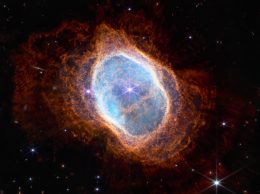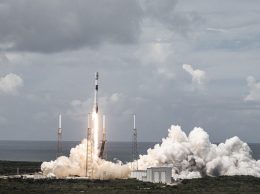SpaceX’s propulsion chief elevates crowd in Santa Barbara
IN THIS ARTICLE
- Technology Topic
- Stephen Nellis Author
By Stephen Nellis Wednesday, February 19th, 2014
Tom Mueller, the head of rocket engine development at Hawthorne-based SpaceX, said there’s been one time he disappointed Elon Musk, the former PayPal co-founder who is head of both the spaceflight startup and electric car maker Tesla Motors.
It was during a test flight of an experimental craft called the Grasshopper, a rocket designed to both take off and land from a vertical position. Last fall, the Grasshopper successfully reached a height of 2,441 feet before landing again, a feat of physics many doubted was possible.
“It didn’t make a crater in the ground like everyone thought it would,” Mueller said. “Elon was a little upset about that. If you don’t crash the thing, you’re not pushing it hard enough.”
Mueller spoke to a crowd of more than 100 in Santa Barbara on Feb. 19 at an event called “Exploring the Next Frontier: The Commercialization of Space is Lifting Off” hosted by the Central Coast MIT Enterprise Forum.
Mueller told the crowd, which included a heavy contingent of high school engineering students, that it was a lifelong dream of his to build rocket engines.
“I was flying model rockets when I was 12,” he said. During high school, “I made a rocket engine out of my dad’s acetylene torch.”
A string of engineering jobs eventually led to a position working on rocket engines at TRW in Southern California. He met Musk, who “Iron Man” director Jon Favreau said inspired the character Tony Stark, just before PayPal went public. Then eBay bought PayPal. Musk turned to rockets and hired Mueller.
“We had enough capital to do rockets. And right from the get-go, we were going to do manned rockets and go to Mars,” Mueller said. “It seemed kind of crazy then, but it doesn’t seem as crazy now.”
That is because the company is under contract to keep the International Space Station supplied and later this year plans to test the most powerful American rocket ever built aside from the now-defunct Saturn V rockets that took U.S. astronauts to the moon. The company has about 4,000 employees.
“Right now, what we’re doing is the evolution, and we’re working on the revolution,” Mueller said.
SpaceX also uses Santa Barbara County’s Vandenberg Air Force Base for about 20 percent of its launches. (Because of its West Coast location, Vandenberg is suitable only for rockets that need to orbit around the poles, rather than the equator.) It conducted an important test one on of its smaller rockets, the Falcon 9, last fall. The test went well, except that when the rocket re-entered the earth’s atmosphere, it began to spin. That caused internal damage that clogged the engines and prevented its re-entry thrusters from softening its fall into the ocean.
“It hit the water at about 100 mph and didn’t survive, but we were really close to recovering that rocket,” Mueller said.
Being able to reuse the pricey upper stage of a rocket is extremely important to costs and efficiency. It’s a key goal at SpaceX. “When you drive to the mall, you don’t want to take a taxi home and then have a tow truck bring your car home. You want to land in your driveway,” he said.
Right now, the company’s Dragon capsule is the only vehicle capable of brining back cargo from the International Space Station, but the end goal is to transport people. “You don’t put a window in a cargo vehicle,” Mueller said of the design.
Safety is a major concern for transporting people into orbit. The company is working on so-called Draco engines that could fire up and provide full thrust within in one tenth of a second. That means the passenger capsule could detect a problem with a launch rocket and blast away from it within a tenth of a second, using the Draco engines for a safe, controlled touchdown on land or sea. Mueller said that could prevent disasters like the deaths of the crews aboard the shuttles Challenger and Columbia.
“If the astronauts had had an escape system, they could have survived that,” Mueller said.
But the company’s true goal remains Mars. Mueller said Musk’s office has two giant pictures of Mars – one as the red planet looks today, and one as it might look if colonized.
These days, Mueller’s main focus is the Raptor engine, a reusable power plant that would use liquid methane and oxygen and provide 1 million pounds of thrust. Nine of them would be combined on one craft.
“It’s going to put over 100 tons of cargo up to Mars,” Mueller said. “That’s what it takes to get to Mars.”
[FULL DISCLOSURE: The Pacific Coast Business Times is a media sponsor of the Central Coast MIT Enterprise Forum, and Stephen Nellis serves on the organization’s board of directors.] [Editor’s note: This story has been corrected to reflect that the Falcon Heavy is the second-largest American rocket ever built.]Related Articles
 Thursday, July 21st, 2022
Thursday, July 21st, 2022










